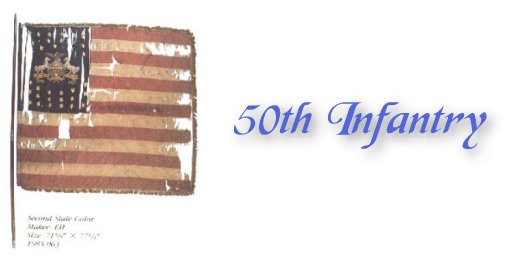
Jeremiah and Samuel Moll
50th PA Regiment Infantry.
Private Samuel Moll (b: 16 Jan 1837, d: 19 Aug 1904, 5th Gen) Private Samuel Moll also served in the 50th PA, Company "E". He enlisted at age 27 on 17 Feb 1864 in Reading and was mustered out on 30 July 1865. Samuel Moll was the oldest son of Benjamin Moll (b: 29 Nov 1812, d: 25 May 1868, 4th Gen) and Elisabeth Lesher Moll (b: 2 Nov 1815, d: 7 Dec 1884).
Samuel Moll was 5' 7" tall, had brown hair and grey eyes. At the time of his enlistment, he listed his occupation as a farmer.
Jeremiah Moll was a cousin of Samuel Moll. He was 5' 7" tall, had sandy hair, and grey eyes. At the time of his enlistment, he listed his occupation as a mason.
The 50th PA was recruited at Reading, Berks County, and known as "Ellsworth's Zouaves".
1861/1862: The unit left Camp Curtin, near Harrisburg, 2 Oct 1861 for Washington, after which it moved to Annapolis and joined the expedition to South Carolina. The regiment embarked on naval transports and steamed south to occupy Hilton Head Island, SC, whose Confederate forts had been captured by a Federal naval force. The 50th landed on the island and proceeded to occupy Beaufort, SC, remaining on Hilton Head until mid-July, 1862.
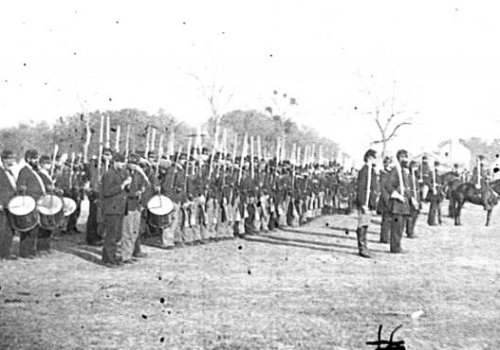
Beaufort, S.C. 50th Pennsylvania Infantry in parade formation, Feburary 1862.
During it's tour of garrison duty there, it skirmished with Confederate forces in several small engagements. One of these, a minor affar at Port Royal Ferry, occoured on 1 Jan 1862. The regiment suffered only two men wounded as it attacked and destroyed an unfinished Confederate fort on the mainland. In May an attempt was made to destroy the railroad bridge at old Pocotaligo, which was unsuccessful in spite of the gallantry of the regiment.
On July 12th, 1862 the brigade was transferred to Virginia, where it became part of Burnside's 9th Corps, where it remained until 1865. After debarking at Fort Monroe, the regiment moved to Fredicksburg, where it skirmished with the advance guard of Lee's army along the Rappahannock and Rapidian rivers. The 50th then fought in the 2nd Battle of Manassas, August 29-30th, 1862 and in the succeeding engagements at Centerville and Chantilly, as the retreating Federal army returned to Washington, it sustained heavy losses.
When Lee invaded Maryland, the 50th was marginally engaged in the Battle of South Mountain on September 14th, suffering only two casulaties. Three days later, on September 17th, the regiment engaged in the bloddy Battle of Antietam, losing nine killed and 31 wounded during the advance of Burnside's corps on the left flank of the army. The 50th was also present on the battlefield of Fredicksburg on December 13th, 1862, but not in the battle.
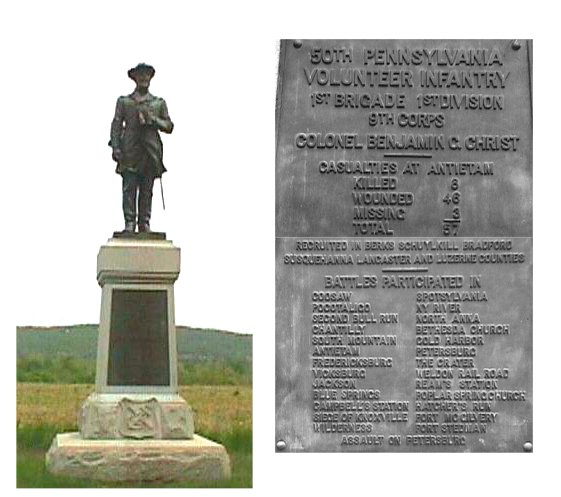
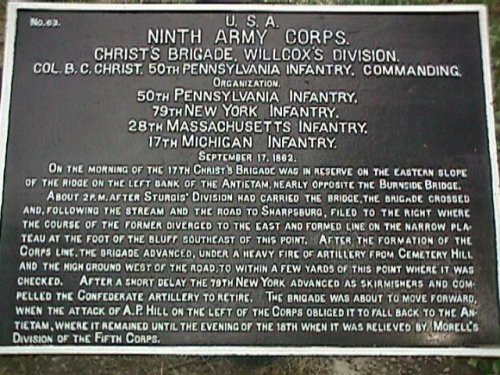
1863: Upon the conclustion of the 1862 Virginia campaigns, the 50th was transferred to the Department of the Ohio, arriving in northern Kentucky in March 1863. It was initially stationed as garrison troops at Camp Dick Robertson, Stanford and Somerset, KY. When General Grant needed reinforcements to aid in his siege of Vicksburg, MS, the 50th was moved by rail and steamboat to join Grant's army in early June where it was posted on Haines Bluff, and after the siege followed Gen. Sherman to Jackson, where it was engaged and helped capture the capital of Mississippi.
The Mississippi campaign was very hard on the 50th, which was greatly reduced in strength as a result of malaria, and on August 10th, 1863 was returned to Kentucky. In September, they marched into eastern Tennessee, where they were engaged at the battle of Blue Springs, Tenn., in October and in November at Lenoir Station and Campbell's station (see below), near Knoxville, and the attack on Fort Sanders. The 50th shared in the pursuit of Longstreet as far as Blaine's cross-roads, when it was ordered to Nicholasville and the reenlisted men were sent home on veteran furlough to Camp Curtin.
1864: In spite of the hardships of the winter nearly the entire regiment reenlisted and on March 20, 1864, reported at Annapolis, the rendezvous of the 9th corps. The 50th was attached to the 2nd brigade, 1st division, of this corps, which joined the Army of the Potomac at the Rapidan on May 5.
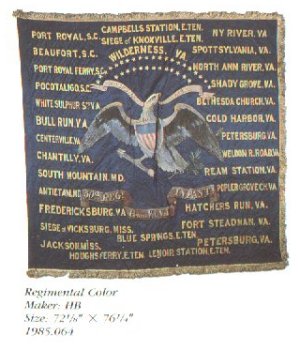 50th PVI Regimental Color. This flag was probably obtained for the May 25th Grand Review in Washington, DC. It contains the names of all the battles and skirmishes in which the regiment participated. |
After the Battle of Spottsylvania ended, the 50th was engaged in succeeding battles as Grant's troops pressed southward and eventually besieged Petersburg. The 50th fought at Cold Harbor (June 3-7th) and participated in the initial unsuccessful assaults on Petersburg in mid-June. By the end of July, after particpating in the Battle of the Crater and Popular Springs Church on September 30th, the 50th was withdrawn from active operations, during which time many new recurits were recieved and drilled.
The 50th returned to engage the Confederates at the Battle of Hatcher's Run on October 27th, then spent the winter of 1864/65 garrisoning part of the trench system around Petersburg.
1865: On March 25th, the 50th participated in the recapture of Fort Stedman, and was present when the Confederates were attacked on April 2nd, during the final assualt on Petersburg. Shortly after the city's surrender, it proceeded to Washington and remained there until June 30, when it was ordered to Gettysburg to represent the infantry of the Union army at the corner stone ceremonies of the National Monument, July 4, and returned to camp at Georgetown, where it was mustered out on July 31, 1865.
The regiment lost during service 8 Officers and 156 Enlisted men killed and mortally wounded and 4 Officers and 180 Enlisted men by disease. Total 348.
The 50th PVI was chosen by General Grant to be the army representative at the laying of the cornerstone of the National Monument at Gettysburg, July 4, 1865.
Engagements
Fought on 21 June 1862 at Beaufort, SC.
Fought on 01 August 1862 at Pocotaligo, SC.
Fought on 28-30 August 1862 at 2nd Bull Run, VA.
Fought on 01 September 1862 at Chantilly, VA.
Fought on 14 September 1862 at South Mountain, MD.
Fought on 17 September 1862 at Antietam, MD.
Fought on 22 October 1862 at Pocotaligo, SC.
Fought on 13 December 1862 at Fredericksburg, VA.
Fought on 16 July 1863 at Jackson, MS.
Fought on 10 October 1863 at Blue Springs, TN.
Fought on 14 December 1863 at Mine Run, VA.
Fought on 6-9 May 1864 at Wilderness, VA.
Fought on 11-15 May 1864 at Spotsylvania Court House, VA.
Fought on 30 May 1864 at North Anna River, VA.
Fought on 2-7 June 1864 at Cold Harbor, VA.
Fought on 17 June - 17 August 1864 at Petersburg, VA.
Fought on 19 August 1864 at Weldon Railroad, VA.
Fought on 30 September 1864 at Poplar Springs Church, VA.
Fought on 28 March - 2 April 1865 at Petersburg, VA.
16 November 1863**
Following parallel routes, Longstreet and Burnside raced for Campbell's Station, a hamlet where the Concord Road, from the south, intersected the Kingston Road to Knoxville. Burnside hoped to reach the crossroads first and continue on to safety in Knoxville; Longstreet planned to reach the crossroads and hold it, which would prevent Burnside from gaining Knoxville and force him to fight outside his earthworks. By forced marching, on a rainy November 16, Maj. Gen. Ambrose E. Burnside's advance reached the vital intersection and deployed first. The main column arrived at noon with the baggage train just behind. Scarcely 15 minutes later, Longstreet's Confederates approached. Longstreet attempted a double envelopment: attacks timed to strike both Union flanks simultaneously. Maj. Gen. Lafayette McLaw's Confederate division struck with such force that the Union right had to redeploy, but held. Brig. Gen. Micah Jenkins's Confederate division maneuvered ineffectively as it advanced and was unable to turn the Union left. Burnside ordered his two divisions astride the Kingston Road to withdraw three-quarters of a mile to a ridge in their rear. This was accomplished without confusion. The Confederates suspended their attack while Burnside continued his retrograde movement to Knoxville. Had Longstreet reached Campbell's Station first, the Knoxville Campaign's results might have been different. Union losses were about 400, Confederate just under 600. ** Note, I lived in Farragut (Current day Cambell's Station), Tennessee from 1993 through 2001 - Brent W. Moll. |